by Roger Meyer
The first flight around Australia was in a seaplane, and was achieved by RAAF officers Goble and McIntyre in a Fairey IIID. The trip began at Point Cook, Victoria, on 6 April 1924 and concluded 44 days later. The duo covered 8,450 miles in 93 hours flying time.
The purpose of this story, however, is to relate a flight which occurred just weeks later: the first round-Australia trip in a landplane. This remarkable flight was achieved by three Civil Aviation Branch (CAB) officers while on official business.
The flight was made for practical reasons. The first was to survey aerodromes and aerial routes, particularly to link Darwin to Perth, and Darwin to Melbourne. The second main objective was to test the efficiency of the De Havilland D.H.50 aircraft on long distance cross-country flights. The contractors of three mail and passenger services, Western Australian Airways Ltd., Q.A.N.T.A.S., and Larkin Aircraft Supply Co Ltd had all ordered the D.H.50. Another purpose of the flight, then, was to give practical demonstrations of the aircraft to contractors’ staffs both at terminal and intermediate aerodromes.
The crew comprised three members of the CAB. Lt Col H.C. Brinsmead OBE MC and Controller of Civil Aviation was leader of the expedition. Captain E.J. Jones MC DFC the Superintendent of Flying Operations and Personnel piloted the aircraft, while Mr R.H. Buchanan, an assistant Superintendent of Engineering, was the mechanic. Their aircraft was the CAB’s new D.H.50, registered G-AUAB, and powered by a 230 h.p. Puma engine. The aircraft provided cabin accommodation for four passengers, but the pilot remained in his traditional cockpit exposed to the elements.
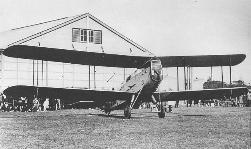
Captain Jones had previously participated in pioneering flights and
accident investigations in Australia. In 1921 he made a trans-continental
flight from Melbourne to Derby, WA, and return on an official tour with
Brinsmead. Again, in 1922 he and Brinsmead inspected the Q.A.N.T.A.S.
air routes and arrangements in Queensland.
Mr Buchanan, a Scotsman, worked in the Charleville railway workshops for six years before enlisting in the AIF. His engineering ability was recognised during wartime service with the Australian Flying Corps, and the Civil Aviation Branch later secured his services. He ensured the maintenance of safety standards by Australian aircraft operators in that early pioneering era.
The start of the tour from Point Cook on the morning of 7 August 1924 was anything but a quiet affair. Mrs Brinsmead accompanied the Controller, while the pilot motored down from Melbourne with Mrs Jones, his parents and a brother. The engineer arrived solo, the Buchanans being residents of Charleville, Queensland. Mr D.S. Aarons and Mr W.H. Judd represented the Vacuum Oil Company, which was responsible for the fuelling arrangements. From the CAB came Captain F.W. Follett, Aircraft Inspector O.J. Howard and Captain S.H. Crawford, the Chief Clerk. The preliminaries were brief while kit and spares were being stowed aboard in small collapsible picnic hampers. Felix, a particularly hideous toy cat, was lashed to the main strut where he remained for the next 22 days.
Hurried farewells, Inspector Howard swung the prop. and at precisely 10.30 am the D.H.50 left the ground and quickly disappeared in the direction of NSW, escorted by six RAAF machines which returned to the ‘drome a few minutes later.
The trip was undertaken in three stages: Melbourne to Darwin, Darwin to Perth and Perth to Melbourne. On average, they travelled 250 miles each day with only one rest day during the entire trip of 22 days. Click here to read an account by Mr S.H. McMaster who, as a young boy, had his first sight of an aeroplane when G-AUAB landed at Temora, NSW.
Aircraft magazine relates a typical day, 12 August, when the intrepid travellers covered 435 miles from Cloncurry, via Brunette Downs, to Camooweal.
"Cloncurry
was left at 7.55 am, the machine, heavily loaded, climbing to 3,800
ft in eight minutes at 1,200 r.p.m. For the first two hours the route
lay over mountainous country, opening out into vast stretches of Mitchell
grass. After passing Malbon, McGregor Junction and Dutchess, a course
was steered for Mount Isa, and the party looked back on the last railway
line they would see that side of Katherine.
Flying at 4,500 ft., Camooweal was sighted at 10.30 and a landing made
ten minutes later. Here the party was met by Captain
Edgar Johnston, Superintendent of Aerodromes for the CAB, who had
been at work on the Cloncurry – Camooweal sector for some weeks
previously. Morning tea was provided at the Camooweal Hospital by the
resident staff.
Into the air again at 1.50pm and soon they passed over Barclay Tableland, Avon Downs, Armchair Bore and finally Brunette Downs, where a landing was made at 4.10. Here the party was welcomed by a carload of jackeroos from the homestead.
Work on the aircraft and engine occupied the next three hours. A visit was then paid to the homestead on the station owned by Mr D. Cotton, father of Major Sidney Cotton, R.A.F., who was the inventor of the "Sidcot" flying suit.
That evening thirteen sat down to an excellent dinner presided over by the station manager (Mr Coleman) and his wife. "The best dinner since leaving Melbourne!" remarked Colonel Brinsmead, with an air of appreciative reminiscence."
On another occasion they were the first air travellers to visit Wyndham, which Colonel Brinsmead described as "the most perfect aerodrome in Australia – a flat claypan, perhaps nine miles long by three miles wide, and the surface so smooth that it might have been a parade ground for years."
The entire trip was quite without serious incident. In his diary Brinsmead recorded his appreciation of the crew. "Both Captain Jones and Inspector Buchanan have worked like Trojans and need restraining rather than driving. The one has not made a single bad landing and has never left the line [course], although some of the grounds have been filthy. The other is a wonder with an aero-engine and is as keen as mustard to get on with the job."
On conclusion of the flight the Air Council in London sent a cable to Colonel Brinsmead congratulating him "on your fine flight which will help air transport very considerably."
Below: This advertisement shows the route taken by Brinsmead, Jones and Buchanan.
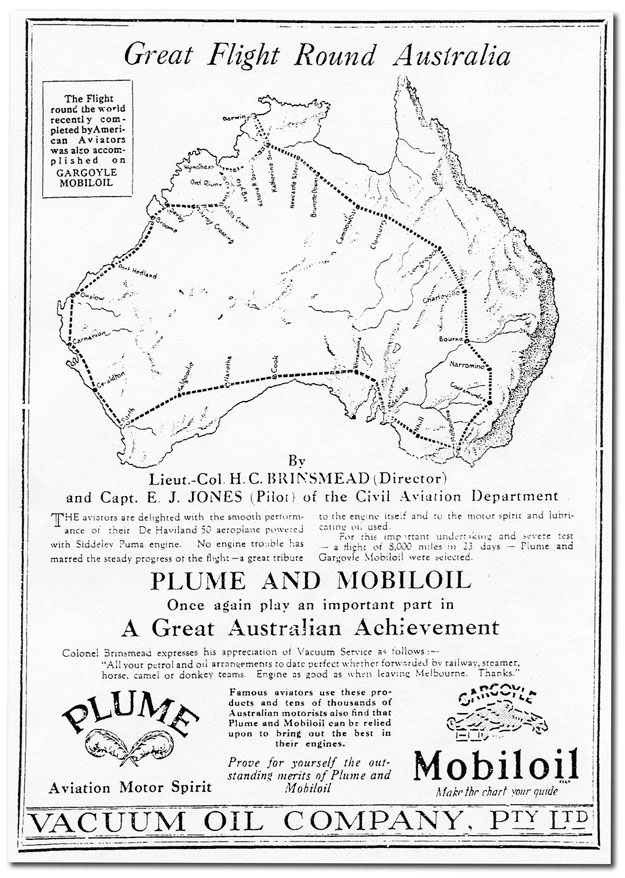
The photo above shows the crew of the first flight around Australia by landplane, undertaken by the CAB's new D.H.50 G-AUAB in 1924. The Controller of Civil Aviation, Lt Col H.C. Brinsmead, is at right. In the centre is Superintendent of Flying Operations Captain E.J. Jones, and on the left is the Branch's mechanic and Assistant Superintendent of Engineering R.H. Buchanan. Buchanan was one of the Branch's two inspectors of aircraft, the other being Mr Howard. Although the location of this photo is not confirmed, it is thought to be Point Cook, Vic., the start and finish point for the flight.
The photos below show G-AUAB at Wyndham during the around-Australia flight in November 1924. In the image immediately below, Brinsmead is standing in the middle and the chap in the white topee is H.F. Sanders, Chief Accountant of the Wyndham meat works and later involved in the post-Second World War Air Beef scheme.
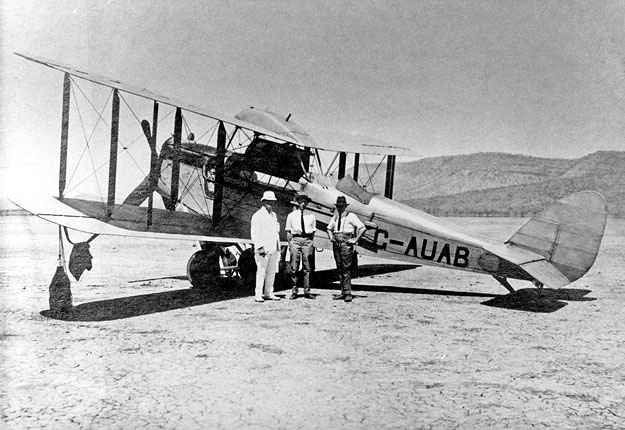
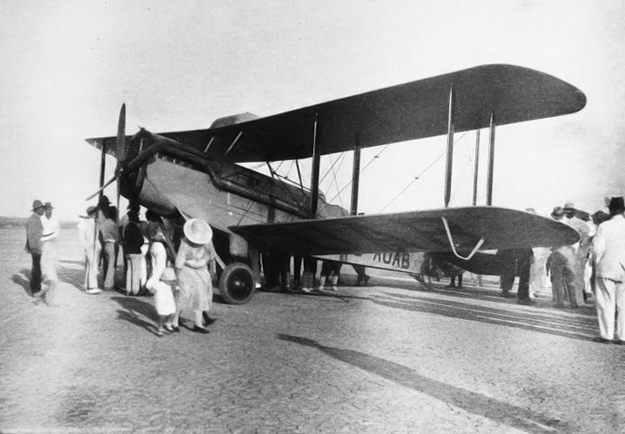
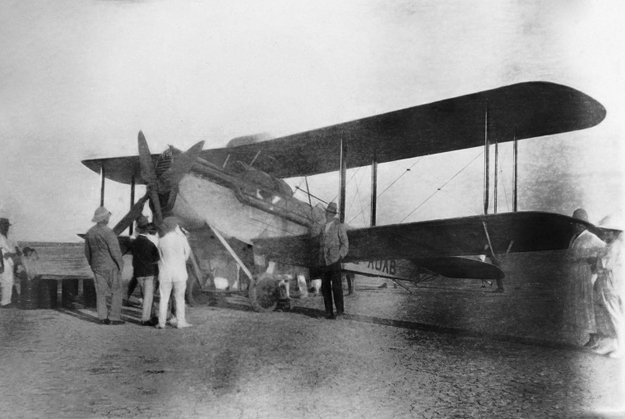
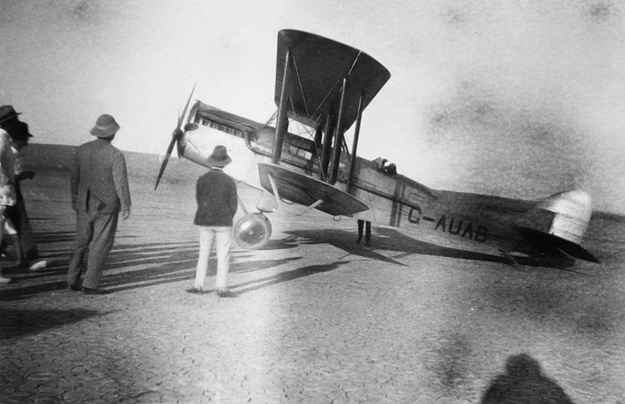
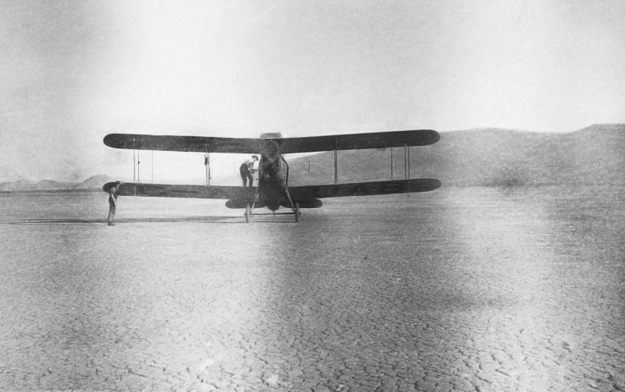
The photo
below was taken at Camooweal flight around Australia. Brinsmead is second from the left at the rear. Also in
the picture is E.J. Jones
(with pipe),
R.H. Buchanan (at left kneeling) and Superintendent of Aerodromes Captain
E.C. Johnston (at right sitting). Not part of the flight, Johnston
was in Queensland surveying aerodrome sites at the time. The man at rear, third from right with the moustache is probably
Fergus McMaster, Chairman of the Qeensland and Northern Territory Aerial
Service (Q.A.N.T.A.S.). The picture was taken at Camooweal hospital,
which was right in town and a popular place.
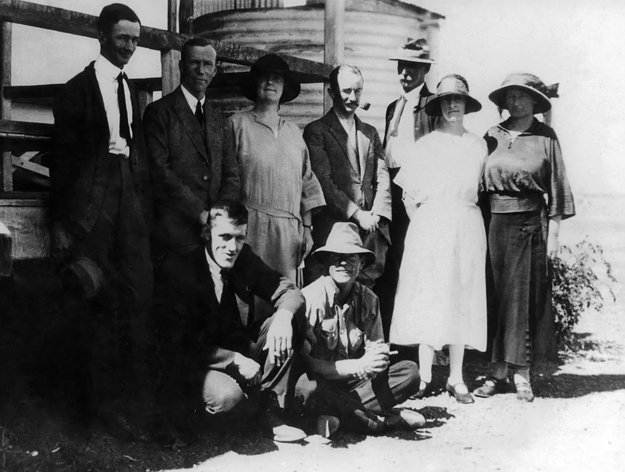
(Photos:
1,2 and 8-CAHS/E.C. Johnston collection / 3-Geoff Goodall collection / 4-7-State Library of Western Australia)
Click here
to return to the main Flying
Operations index
Click here to return to the main Items of General Interest index
If this page appears without menu bars at top or left, click here